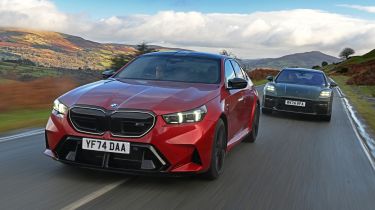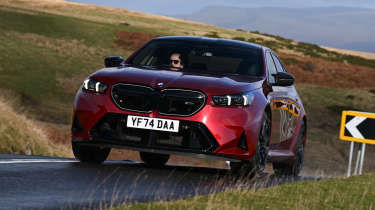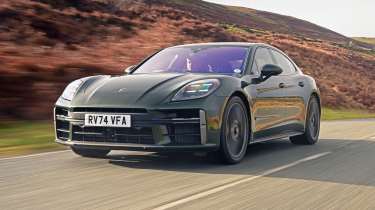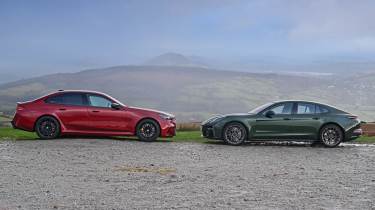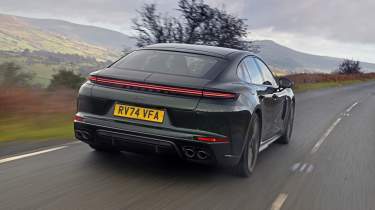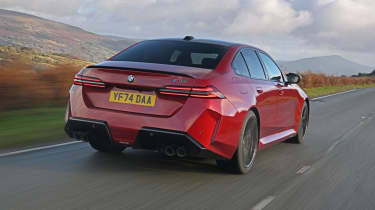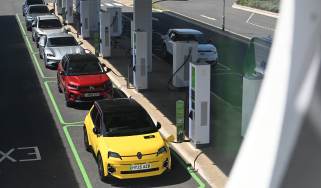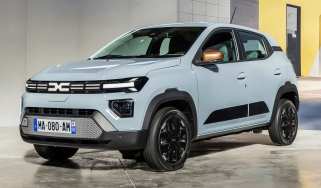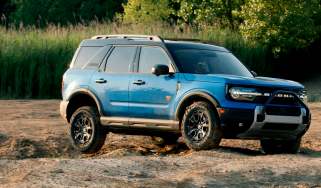BMW M5 vs Porsche Panamera: which is the superior super-saloon?
By combining petrol and electric power, these two super- saloons are more potent than ever, but which is best?
This year marks the 45th birthday of the BMW M5. One of the most lauded performance saloons of the last half century, it’s a car that set the template for supercar performance in a sensible four-door suit.
Now, BMW has unleashed its all-new seventh-generation model, and as expected, it’s the most powerful version of the M5 ever. But that only tells part of the story, because helping to achieve a staggering 717bhp output is a healthy dose of hybrid assistance. The approach has been put to brilliant effect in some performance cars, such as the Ferrari 296 GTB and the McLaren Artura, so we’re fascinated to see if, and how, the plug-in tech can enhance an already compelling formula.
It’s an approach taken by one of the M5’s key rivals, too. While the Porsche Panamera isn’t all-new like the BMW, Stuttgart’s flagship has seen a mid-life refresh. In terms of performance, this Turbo E-Hybrid is closest to matching the incredible on-paper specs of the M5, and it’s working to the same formula of a luxury saloon car with the ability to keep pace with almost anything on the road. So is the M5 still the king of the super-saloons, or does Porsche offer a better solution?
BMW M5
| Model: | BMW M5 |
| Price: | £111,405 |
| Powertrain: | 4.4 V8 twin turbo, 1 x e-motor, 18.6Wh battery, 717bhp |
| 0-62mph: | 3.5 seconds |
| Test efficiency: | 34.0mpg |
| EV range: | 48 miles |
| Annual VED: | £590 |
It might be odd to suggest that the BMW M5 is competitively priced, but with a starting price of around £111,000, it’s on a par with the non-hybrid Audi RS 7 and significantly less expensive than the Panamera, which offers the same sort of performance. Whether those capable of spending well over six figures on a performance car care about such things is another question entirely.
Used - available now

2024 Volkswagen
T-Roc
9,230 milesManualPetrol1.0L
Cash £18,299
2023 Peugeot
E-2008
18,400 milesAutomaticElectric
Cash £14,999
2017 Honda
Civic
43,560 milesManualPetrol1.0L
Cash £9,699
2020 BMW
1 Series
73,340 milesAutomaticPetrol1.5L
Cash £15,774Tester’s notes
Our M5 test car was equipped with a Bowers & Wilkins audio set-up, and it’s one of the very best in the business. Clarity, power and overall performance from the 18-speaker system are outstanding. On weaker sound systems, the bassy drones of a car’s tyres at motorway speeds can drown out the lower frequencies of music, but the B&W system has a subwoofer beneath each front seat to compensate, so regardless of where you’re driving, the music needn’t stop. Or, there’s always the roar of that V8 to appreciate instead.
Porsche Panamera
| Model: | Porsche Panamera Turbo E-Hybrid |
| Price: | £145,400 |
| Powertrain: | 4.0 V8 twin turbo, 1 x e-motor, 21.8kWh battery, 671bhp |
| 0-62mph: | 3.2 seconds |
| Test efficiency: | 35.1mpg |
| EV range: | 49 miles |
| Annual VED: | £590 |
Priced at more than £145,000, the Porsche Panamera Turbo E-Hybrid finds itself in something of a middle ground, fighting off the Bentley Flying Spur above and less expensive, but similarly rapid, alternatives such as the BMW M5 and Audi RS 7.
For the Panamera’s mid-life revisions, Porsche has introduced subtle styling tweaks (the more bluff front bumper with squared-off intakes is the most notable), plus other more significant changes under the skin.
Many of these focus on the chassis, with a new and improved air-suspension system (known as Porsche Active Suspension Management, or PASM) fitted on every model, while active ride tech is available on the E-Hybrid variants. The option, which costs a hefty £6,978, was fitted to our test car.
Tester’s notes
As before, the Panamera is also offered with more modest powertrain choices than the most potent V8 options. These start with the 2.9-litre V6, which is plenty quick enough for most buyers already, and escalate to the car that Porsche believes will appeal the most to keen drivers – the GTS. Using a slightly detuned version of the 4.0-litre V8 in the Turbo E-Hybrid that makes 493bhp and 660Nm, it also loses the battery pack, so it weighs at least 375kg less than the PHEV models.
Head-to-head
On the road
Neither of these cars feels like an out-and-out performance saloon – both are too bulky for that. Of the two, the BMW is a little more direct, which we suspect would make it slightly quicker around a track, but the Porsche manages to run it close for cross-country pace, while offering a more natural feel. It’s also a more comfortable car to live with during the 99 per cent of the time you’re driving normally.
Tech highlights
Both cars use clever plug-in hybrid systems to augment the power from thunderous V8 engines. The Porsche’s battery has a usable capacity of 21.8kWh – 3.2kWh more than the M5’s – its energy feeding an e-motor with 187bhp and 450Nm of torque. The M5 makes 7bhp more, but 280Nm of torque. However, a patented gearing system enables it to deliver the same 450Nm overall at the wheels.
Price and running
In the short term, this pair’s plug-in powertrains will ensure both models appeal to wealthy company car drivers. An Audi RS 6 faces annual Benefit-in-Kind deductions of £17,509 – five times more than the M5, and almost four times the Panamera’s. However, due to a change in the way plug-in hybrid emissions are calculated, that gap will close soon. Both cover roughly 40 miles of EV-only driving.
Practicality
The need to package petrol and electric powertrains means that both of these cars are a little compromised in boot space; volumes of 466 litres for the BMW and 421 litres for the Porsche aren’t that impressive. However, their cabins are spacious. The M5, in particular, is vast in the back, with slightly more headroom and kneeroom than its rival. The Porsche is still roomy, though, and feels more luxurious.
Safety
The Panamera hasn’t been tested by Euro NCAP, but the latest updates introduced a wider range of driver-assistance systems. NCAP has assessed the BMW in electric i5 form, where it achieved a maximum five-star rating. Camera and radar-based driver-assistance systems come as standard on the M5, but adaptive cruise control and surround-view cameras are optional extras on the Porsche.
Ownership
In terms of mileage and duration, both cars have matching warranties and recovery plans, so there’s nothing to separate them here. Porsche owners tend to be more satisfied with their cars than BMW drivers, though. In our 2024 Driver Power survey, Porsche was rated as the fourth best manufacturer. BMW’s 14th-place finish still put it in the top half of the table and ahead of every other German brand.
Verdict
Winner: Porsche Panamera Turbo E-Hybrid
Small updates have enhanced what was already a brilliant all-round GT car, and it’s enough to see Porsche reign supreme over BMW in this contest. Performance, handling, comfort and quality are all first rate, and make any journey feel like an event. There’s slick in-car tech and (boot aside) plenty of space, too. Even so, we’re not convinced the Panamera is at its best with plug-in hybrid power – we’d sacrifice a touch of straight-line speed and choose the lighter Panamera GTS, saving a huge amount of cash in the process.
Runner-up: BMW M5
There’s a huge amount to like about the new M5. Straight-line speed and its point-to-point pace are incredible, while it’s all wrapped up in a more menacing version of a car that offers all of the existing 5 Series strong points such as interior space and slick tech. However, there are compromises in one or two areas which the Panamera reveals; it’s not quite refined enough to compete with the Porsche, yet too big and bulky to feel like a bona-fide super-saloon. It’s undoubtedly a great car, but it won’t go down as one of the great M5s.
Prices and specs
| BMW M5 | Porsche Panamera Turbo E-Hybrid | |
| Price from/price of our choice | £111,405/£130,905 | £145,400/£145,400 |
| Powertrain and performance | ||
| Engine | V8 twin-turbo/4,395cc | V8 twin-turbo/3,996cc |
| HEV motor power/torque | Motor 194bhp/280Nm | 187bhp/450Nm |
| Total power/torque | 717bhp/1,000Nm | 671bhp/930Nm |
| Transmission | Eight-speed auto/4WD | Eight-speed auto/4WD |
| 0-62mph/top speed | 3.5 secs/190mph | 3.2 secs/196mph |
| Fuel tank/battery capacity | 60 litres/18.6kWh | 80 litres/21.8kWh |
| MPG (WLTP/test) | 166.2/34.0mpg | 134.5/35.1mpg |
| WLTP all-electric range | 48 miles | 49 miles |
| Dimensions | ||
| Length/wheelbase | 5,096/3,006mm | 5,054/2,950mm |
| Width/height | 1,970/1,510mm | 1,937/1,421mm |
| Rear kneeroom | 610-880mm | 627-854mm |
| Rear headroom/elbow room | 969/1,497mm | 940-1,495mm |
| Boot space (seats up/down) | 466 litres/N/A | 421/1,255 litres |
| Boot length/width | 1,100/810mm | 1,052-896mm |
| Boot lip height | 700mm | 765mm |
| Kerbweight/payload/towing weight | 2,510/2,000kg | 2,435kg/N/A |
| Turning circle | 12.6 metres | 11.7 metres |
| Costs/ownership | ||
| Residual value (after 3yrs/36,000 miles) | £58,619 | £76,219 |
| Depreciation | 44.78% | 52.42% |
| Insurance group/quote/VED | 50/£3,293/£590 | 50/£3,175/£590 |
| Three-year service cost | £2,310 | N/A |
| Annual tax liability standard/higher rate | £1,782/£3,563 | £2,262/£4,545 |
| Annual fuel cost (10k miles) | £1,833 | £1,771 |
| Basic warranty (miles)/recovery | 3yrs (unlimited)/3yrs | 3yrs (unlimited)/3yrs |
| Driver Power manufacturer position (2024) | 14th | 4th |
| NCAP Adult/child/ped./assist/stars | 89/85/86/78/5 (2023) | N/A |
| Equipment | ||
| Metallic paint/wheel size | £0/20 inches | £0/20 inches |
| Parking sensors/camera | Front & rear/360-degree | Front & rear/rear |
| Spare wheel/Isofix points | Repair kit/two | Repair kit/two |
| Keyless entry & go/powered tailgate | Yes/yes | Yes/yes |
| Leather/heated seats | Yes/yes | Yes/yes |
| Screen size/digital dashboard | 14.9 inches/yes | 10.9 inches/yes |
| Climate control/panoramic sunroof | Yes/yes | Yes/£1,818 |
| USBs/wireless charging | Four/yes | Four/yes |
| Wireless Apple CarPlay/Android Auto | Yes/yes | £740/Yes |
| Blind-spot warning/head-up display | Yes/Yes | Yes/Yes |
| Adaptive cruise/steering assist | Yes/yes | £1,274/£2,327 |

